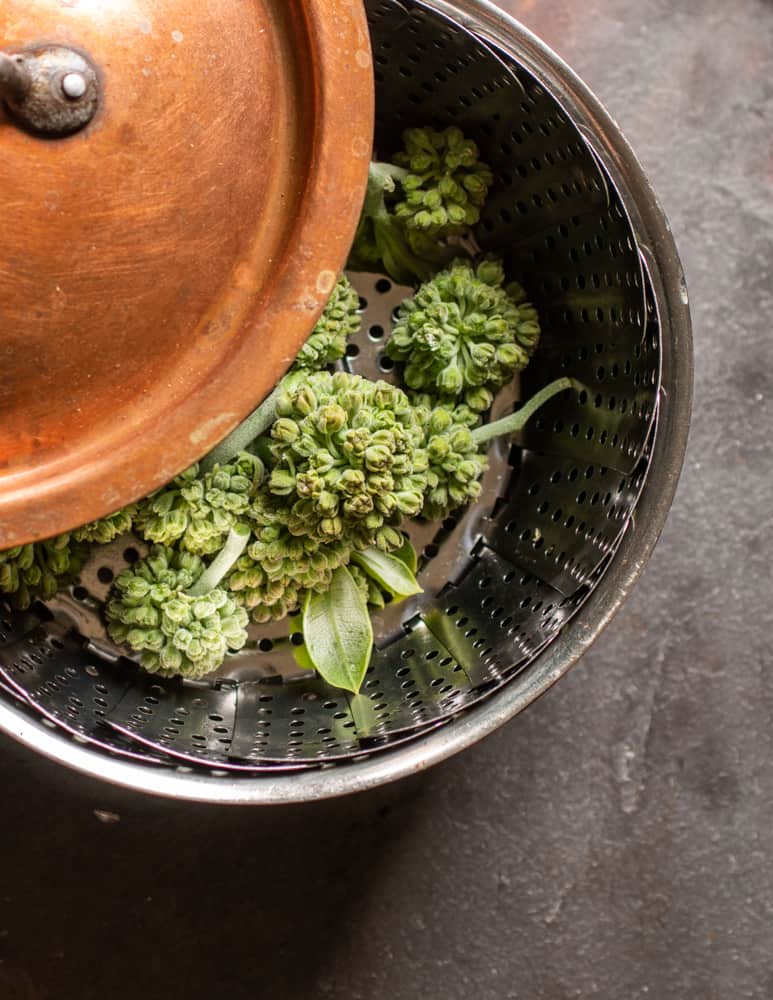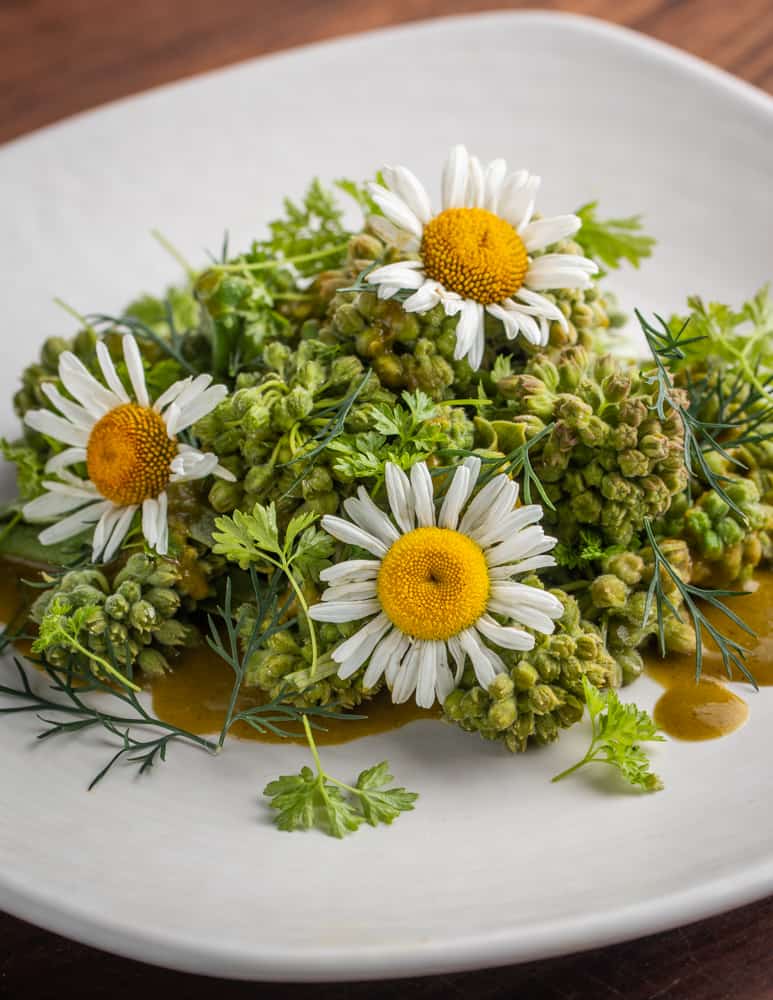Milkweed flower buds were one of the first wild foods I harvested, and steaming them has become one of my favorite milkweed recipes. But, before you go out and gather a bunch, there's a few things to know to make sure you have the best experience.

If you're new to eating this plant, it's important to remember that only a few species of milkweed are edible. I have only cooked common milkweed (Asclepias syriaca), but showy milkweed (Asclepias speciosa) can be eaten too. For more info on milkweed as a food in general, I recommend reading Sam Thayer's Book The Forager's Harvest.

The buds (or milkweed raabs as I call them) are the unopened flowers of the plant, harvested when they're green in the early summer. At a glace they resemble broccoli broccoli florets with a taste reminiscent of green beans.
While the buds and flowers of the plant are edible at any stage, I like them best when they're tight and compact. Loose or floppy buds won't keep their shape after cooking and get kind of flat.
Harvesting
First you want to find a large colony of milkweed. I don’t typically harvest any buds from plants unless I’m in a field of them with more than I could ever harvest.

You can harvest the entire tender tops of the plant, or just the tightly clustered flower buds. I always like to leave a couple buds on each plant for the monarchs too.

As milkweed sap is sticky and can gunk up my harvesting basket, I like to put the buds in a polycarbonate container or plastic bus tub. It’s also a good idea to wear gloves to prevent your hands from getting sticky, but if you don’t have any the sticky sap is nothing some hot soapy water can’t fix.

Before you take each bud, make sure to look it over for insects. Insects rely on milkweed for food too, so If I see any ants, bees, or especially monarch caterpillars on the plant, I leave it alone and move onto the next plant.
Cleaning
When you get home, lay the buds out on a tray in a flat layer and inspect them visually again for insects, rehoming any you find.
Next, I remove any leaves larger than 1 inch. Older leaves are tough an unpalatable, and I use them primarily for making purees. You want mostly buds here, but a few small leaves here and there won’t bother anyone. After you’ve inspected the buds, store them in a large zip-top bag in the fridge. They’ll last for 5-6 days just fine.

Safety
Milkweed is a traditional food, but it does require some thought when you're preparing it. The most important thing to know is that the plant should never be eaten raw, with the exception of the occasional sprinkling of raw flowers that I've used to garnish plates for years now.

The other important thing to consider is the amount of milkweed that's suitable to eat. I'll going to break down the cooking methods and importance of portion size below.
Steaming vs Blanching
If you look at most resources or field guides, the cooking recommendations vary wildly. Some will claim that any part of the plant must be boiled in multiple changes of water. I think repeated boiling is unnecessary, and a borderline insult to the plant.
Sure, you can blanch or boil milkweed buds and it can be ok, but at the most you only need a minute or two before you cook them again in a pan. I'd wager I served a couple hundred pounds of milkweed buds cooked like that at my restaurants over the course of three years to the general public and never had an issue.

The multiple boiling, in my opinion, is just a catch-all technique for many wild plants that gets applied to milkweed because it will make it safe, but it isn't the only way. Steaming works just fine too, and the buds will keep a better texture.
Portion size
Whether you boil or steam them, it's important to know that individual sensitivities vary greatly, and while I may be able to sit down and eat 8 ounces of steamed milkweed buds in a sitting, most people should start with a much smaller portion. Eating too much cooked milkweed, just like eating too many brownies, can make you sick.

What I recommend is starting with a portion size of 2 ounces raw milkweed buds as a serving for one adult. If you know you digest them well, you can try a little more, but after eating more than four ounces of cooked buds, I start to get tummy rumbles-nothing painful or uncomfortable, just a little gurgle here and there. The same thing happens when I eat a large bowl of cooked morels.
Serving and enjoying
This is one of those recipes that's so easy I feel like it hardly needs a description, and the most basic version really doesn't. When I just want to enjoy a few cooked buds I'll steam them for five minutes, then remove and nap with soft butter, a pinch of salt, and a squeeze of lemon.

There's something really special with steaming. When the buds are blanched, their structure is such that they tend to soak up a lot of water and get a heavy feeling to them. This isn't bad if they're tucked into a sauce or tossed with pasta, but it's noticeable.
Steaming bypasses the waterlogging issue. But, after cooking, the buds will taste a little dry, and they cry out for fat and seasoning. There's a lot of different ways you can quench the buds thirst for seasoning.
To give you some ideas, in the video in this post I demonstrate two different methods. First, the most basic: a side dish with a little butter, olive or sesame oil. Secondly, with a special sauce I make from fermented ramp leaves garnished with fresh herbs and flowers. I also like them steamed in the morning with eggs and hot sauce.

Related Posts
References
Steamed Milkweed Flower Buds
Equipment
- Steamer basket
- 3-4 quart pot with a tight-fitting lid
Ingredients
- 4 oz fresh milkweed buds or tender tops
- Soft butter and kosher salt for serving (it’s ok to use salted butter too)
- Water for steaming, about 3 cups
Instructions
- To steam the buds, put the water in a pot, then put in the steam insert, top with a lid, and turn the heat to high. When the pot comes to a boil, add the milkweed buds, distributing them so they’re in a uniform layer to promote even cooking.
- Put the lid on the pot, then start a timer for 5 minutes, turning the heat down to medium-high.
- After five minutes, remove the buds to a serving dish, drizzle with melted butter and a sprinkle of kosher salt and enjoy, starting with 2 oz of steamed buds per adult.
- Alternately, put a bowl of steamed buds on the table and spread them with a knob of soft butter as you would rice or other steamed vegetables. Pass some nice salt or kosher salt and lemon wedges at the table.


Lisa Solomon
I’ve never tried milkweed before - Delicious! I wish it was the start of milkweed bud season and not the end. Thank you for sharing your recipes.
Alan Bergo
Thanks Lisa.
Katie Goin
Well ! I just cooked a bunch of milkweed buds today … boiled for 8 minutes like the internut told me 🥴 they were soggy and sad. Thanks for this ! I will head out tomorrow for more and try them steamed! Excited 👍🌿
Alan Bergo
Yep, that's exactly what happens. Steaming keeps their integrity much better.
Coop
If you pick milkweed buds, please don't take the entire young top of the plant. Each healthy plant will produce up to 8 to 10 flower clusters if left to bloom. If you pick the entire tip, that's it for the season. If you harvest only individual bud clusters as they reach the perfect size, you can harvest large quantities for yourself repeatedly over a long period, while still leaving plenty for wildlife and to go to seed. There's no reason you should ever have leaves included if you pick this way. There are a number of other fairly uncommon insects that depend on milkweed, not just the monarch butterflies. One of these is the Red Milkweed Bug, Tetraopes tetrophthalmus, which is one of the few insects that vocalizes; making both squeaking and purring sounds. Please harvest wild plants responsibly and don't be greedy!
Alan Bergo
I agree, but this is beyond the scope of this post. I cover sustainability in a longer article.
Laura
I've heard that the recommendation to boil milkweed in multiple changes of water came from Euell Gibbons, who may have confused dogbane for milkweed with some unpleasant gastric side effects. This was probably shoots, if it's even true.
Heather
Euell Gibbons was an expert who really knew his edible wild plants. I doubt he confused milkweed with dogbane. His recommendation was probably influenced by the cooking practices of his time and "just to be safe". His books are full of wonderful and creative ways of using wild plants for food- spoken of in a way that tells me it's first hand knowledge.
Alan Bergo
I just love him.
Alan Bergo
A long time ago I confused the two. Dogbane is so bitter it's a mistake you only make once.
Will K.
I did the same thing when I first started foraging, probably 45 years ago. No matter how many changes of water I used, the dogbane shoots never lost their bitterness- good thing I couldn't choke them down. I'll have to try steaming milkweed buds; I mostly blanch them quickly, then toss in a pan with olive oil and garlic, then hit them with a squeeze of lemon.